Welcome back for a third installment on our Elevate Q&A series, where we “pass the mic” to a member of our extended philanthropic family to examine issues pertinent to the sector and nonprofits! (If you missed our previous conversations, please check out our Q&As with Wade Munday, Bridgestone America’s Director of Corporate Philanthropy; and April Walker, founder of Philanthropy for the People, where we explored some of the challenges and opportunities nonprofits and philanthropists face in pursuing a more equitable approach to their work.)
This time, I spoke with Brian Rosenbaum, the Development Officer for A Place Called Home (APCH), where he holds a portfolio of 150 major and mid-level donors and oversees the organization’s monthly giving program..
For 30 years, A Place Called Home (APCH) has provided South Central Los Angeles youth with a safe, nurturing environment and proven programs in the arts, education, and wellness to help them improve their economic conditions and develop healthy, fulfilling, and purposeful lives. APCH has directly served more than 20,000 youth members through its core school day, after school and summer programming, and over 150,000 local residents through family and supportive services including food, clothing, and holiday toy distributions, counseling, voter education, and community organizing.
Brian is a Southern California native with 18 years of U.S. and international nonprofit experience. He earned his BA in Psychology and Spanish from UCLA and his Masters in Social Work from Columbia University, specializing in program development and community organizing.
My conversation with Brian covered how he leverages his social work training in his current fundraising work, what he sees as the key to successful partnerships with donors, and how he has implemented DEI principles throughout his career.
What It Takes to Successfully Engage Donors
Johnisha Levi: How do you draw upon your background in social work in your current fundraising role?
Brian Rosenbaum: The core values of social work include meeting people where they are, leveraging a strengths-based approach, and capacity building. Each of these is applicable to nonprofit fundraising and communications.
As a nonprofit leader, I also consider ways in which we can hold space for each other to feel seen, to bring our full selves to our work, and to make our best contributions in this world. It’s about discovering ways to pour inspiration into people.
JL: I imagine these values help you to build strong and trusting relationships among colleagues. How would you describe your approach to building relationships with major donors and other partners?
BR: Something that I like to talk about is how “relationship” is sort of a neutral word. You can have a good relationship. You can have a bad relationship. You can have a distant relationship or a close one. On the other hand, a partnership has only one connotation. If you are partners, you are paired.
In a true partnership, everyone gets their needs met, everyone feels heard and seen. And then you grow together and evolve. That’s how I see my role within my staff, with other departments, and with donors; we are partners, and more specifically, we are partners in impact.
When I was at United Way of Greater LA, one of the ways that we described the role of a fundraiser was as a “philanthropic concierge”. It’s all about understanding the impact that a donor wants to make, their priorities, their capacity, their affinity, and their connection to the cause, and then using this information to compose a menu that is in alignment with their passion and interest with our very real funding needs. In implementing this approach, we created meaningful partnerships with donors that led to real impact for our community.
JL: Can you give me an example of your work with a prospective donor that exemplifies this idea of partnering in impact?
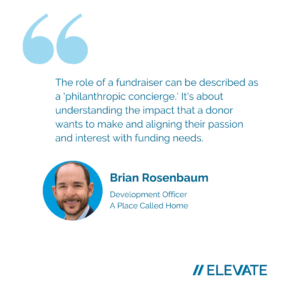 BR: I will share an example of resuscitating a relationship that lapsed prior to my arrival at the Los Angeles Ronald McDonald House. I told my boss, “Challenge accepted.”
BR: I will share an example of resuscitating a relationship that lapsed prior to my arrival at the Los Angeles Ronald McDonald House. I told my boss, “Challenge accepted.”
First, I did a little bit of email outreach to the lapsed donor, and when I didn’t get anything back, I got her on the horn. She was at the grocery store and said she would call back, but she didn’t.
I was tenacious. I got her on the phone again. She shared that she was really disappointed in the lack of appreciation and stewardship. And you know what? Sometimes you just gotta listen. And as a social worker, I embrace any chance I get to listen to people, to really understand what’s going on for them. I told her that I was mortified and angry to hear that she didn’t get the recognition that she deserved. And that she deserved to know the impact of her gift.
I explained how I would do better. I made a list of promises to her, and I delivered on them. Then I brought her in for a tour to see the impact of her gift. At the end of the tour we were sitting down in the dining room having some coffee when she asked about our current needs. I shared a few of our funding priorities, and she said, “Good. Send us a list. You know the things we care about. We’ll see what we can do.”
She and her husband care about safety and security, and comfort and care. So we created a menu with various projects and different price points that were aligned with these interests.
I talked with her several months later. It took some time. But at that point, we settled on a project that satisfied both of our needs – at their previous giving level – and we transformed the broken relationship into a partnership.
Most Important Piece of Advice for a New Fundraiser
JL: You’re clearly a seasoned cultivator and partnership-builder. What advice would you give to a new fundraiser about how to approach donor cultivation?
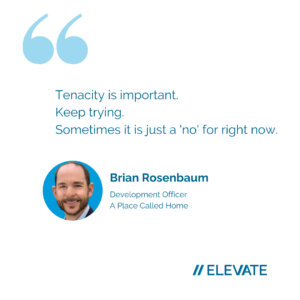 BR: I would say, lean into curiosity, be a sponge. Whether you are stewarding or cultivating donors, know those lists of questions to ask donors from a place of authenticity.
BR: I would say, lean into curiosity, be a sponge. Whether you are stewarding or cultivating donors, know those lists of questions to ask donors from a place of authenticity.
One of my favorite questions to ask that people don’t expect is, “How did you become generous?”
It is also crucial to have genuine curiosity about how a donor would like to be engaged. For example, asking, “Can we schedule some time in two weeks to reconnect to see what you thought about this idea?” Or offering, “Can I send you a quarterly update, because you’re part of our impact?” People rarely say no to this last one.
Tenacity is also important: keep trying. We have to respect donors’ wishes but sometimes it is just a ‘no’ for right now.
The Importance of Applying a DEI Lens
JL: Nonprofits and philanthropists are increasingly focused on ensuring that diversity, equity, and inclusion is the lens through which they implement social change. Can you share a little about your own journey with DEI over the course of your career? What are some of the key lessons you’ve learned?
BR: Graduate school really helped me recognize the power and privilege that I bring into rooms and the fact that every white person is on their own journey of unlearning their racism. Biases are in the air that we breathe. You’ve got some sexism in you. You’ve got some heterosexism in you. You’ve got some ableism in you. You’ve got some nativism in you.
It’s like the moving walkway at the airport; you’re just going to be carried to the end unless you start walking the other way. But it takes a lot of self-work.
I committed myself to doing that work when I came back to LA after grad school, starting with getting involved in AWARE-LA (Alliance of White Anti-Racists Everywhere-Los Angeles). They hold both white-only spaces and multi-racial coalition building spaces with the aim of holding each other accountable and in recognition of the fact that people of color should not have to teach white folks about our own racism.
Subsequent to that, and surrounding the events of 2020 following George Floyd’s murder, I was part of an organization that really took advantage of the opportunity to unpack its past. It opened up a giant, very important conversation about some historical trauma that had happened in the organization and that was still affecting staff.
Out of this process came a renewed sense of responsibility, accountability, and personal growth; you don’t get that opportunity very often.
JL: How do you bring these values that have shaped your own thinking about DEI into your partnership building and donor engagement work?
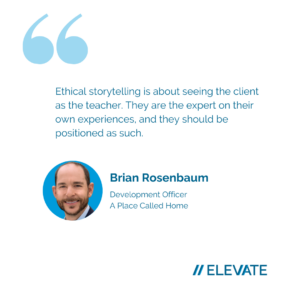 BR: I am passionate about ethical storytelling. This means presenting our clients as the heroes of their own story, not people who are broken and need to be fixed. We might be experts on suicide prevention, or food insecurity, or homelessness, but the client is the teacher: they are the experts on their experiences, and should be positioned as such. Sometimes I explain this as seeing the two sides of the coin when it comes to a person. Everyone has both strengths and struggles.
BR: I am passionate about ethical storytelling. This means presenting our clients as the heroes of their own story, not people who are broken and need to be fixed. We might be experts on suicide prevention, or food insecurity, or homelessness, but the client is the teacher: they are the experts on their experiences, and should be positioned as such. Sometimes I explain this as seeing the two sides of the coin when it comes to a person. Everyone has both strengths and struggles.
Ethical storytelling is about finding the balance – truthfully representing stories and situations so that we are educating our audiences about the issues that people are facing, while also including the nuances, the complexities, all of the realities of the situation.
Every time we don’t use an ethical storytelling lens, we do damage by reinforcing negative stereotypes. Imagine the negative impact on a client who actually reads that story in the newsletter or in the annual report or on social media!
With that client in mind, I aim to apply a frame of ethical storytelling in my work as a fundraiser.
JL: That is sage advice! What are a few best practices when it comes to ethical storytelling that you employ?
BR: I have the site www.ethicalstorytelling.com bookmarked and use it all the time. For instance, there is a great media consent form that we utilize. It offers individuals the power to consent to share their story or their likeness in a way that is comfortable for them.
It is also important to make determinations about how to use client images and video in a way that is complementary and uplifting, as well as to include clients in the editing process, and to allow them to approve content.
Interested in learning more about ethical storytelling principles? Sign up for our August 2024 webinar, Introducing and Empowerment Framework for Grant Writing, and look for more resources coming your way on this blog!
These are some common responses from Executive Directors when asked to cultivate a new foundation partner as part of their organization’s larger grant strategy.
Cultivation is often deprioritized in order to “get proposals out the door,” but organizations that ignore the opportunity to build relationships with funding partners before making an ask are doing themselves a huge disservice. If you are looking for some talking points to convince an Executive Director to take action – or perhaps you need some motivation yourself – check out these five tips.
1. Building name recognition with the funder will help you stand out
 When was the last time that you picked up a phone call from “Unknown Caller”? I’m not sure either. When you submit an application to a funder with whom you have never previously spoken, you are essentially that unknown caller in a giant virtual pile of grant applications.
When was the last time that you picked up a phone call from “Unknown Caller”? I’m not sure either. When you submit an application to a funder with whom you have never previously spoken, you are essentially that unknown caller in a giant virtual pile of grant applications.
Need proof? Elevate clients have received responses to cold submissions like this one from the Robert Wood Johnson Foundation:
“We received 342 proposals and can support only 3-4 projects…”
And this one from the Aetna Foundation:
“ We received close to 1,800 applications from locations across the contiguous United States…”
Instead of resigning yourself to being one of hundreds of virtually anonymous applicants in a stack, cultivation activities give you an opportunity to develop name recognition and – maybe – build excitement with the Program Officer about your work.
Bottom line: Cultivation gives you an advantage over the unknown organizations in the pile, and it increases the likelihood that your proposal will receive serious consideration.
2. Getting clarification early could avoid a huge waste of staff time later
Philanthropy is not immune to a culture of buzzwords – innovation, strategy, moving the needle, etc. Your definition of “innovative” or “strategy” could differ greatly from the funder’s. Speaking with a Program Officer before you spend a great deal of time and effort on a complex proposal could save you the trouble of learning later that your program is not quite innovative enough.
Alternatively, it may present you with the opportunity to convince the Program Officer otherwise. You can prevent your proposal from being tossed aside during a high level review if you have clarified definitions and expectations in advance.
Bottom line: Cultivation could save the organization time and money.
3. Insider information is not shared with the outsiders
 Yes, the funder’s website or RFP will outline the official funding priorities, application guidelines, and deadlines. Do you know what it won’t share? You won’t read about the not-yet-official funding priorities that may be incredibly well-aligned with your program and that may even offer a much larger funding amount. The website also won’t recommend that you apply in this current grant cycle because the next one is much more competitive for a smaller pot of money.
Yes, the funder’s website or RFP will outline the official funding priorities, application guidelines, and deadlines. Do you know what it won’t share? You won’t read about the not-yet-official funding priorities that may be incredibly well-aligned with your program and that may even offer a much larger funding amount. The website also won’t recommend that you apply in this current grant cycle because the next one is much more competitive for a smaller pot of money.
A conversation with a human – via email, phone, or Zoom – is much more likely to give you information that has not yet been made public (or may never be) .
Bottom line: Cultivation gives you access to information that others do not have.
4. Even if a funder isn’t interested, they may know someone who is
Funders network too. Program Officers are aware of who else is granting money to organizations in their issue area and geographical community. Groups such as the Philanthropy Network Greater Philadelphia, Philanthropy DMV, and other regional funder networks and issue-based affinity groups regularly bring together foundations with similar goals.
When you speak with a Program Officer on the phone, it is absolutely possible that they make recommendations for where else you might pursue funding. And you don’t have to wait for them to offer – why not ask, “Do you know of any other foundations who may be interested in supporting this project?” Heck, they may even be willing to make an introduction for you!
Bottom line: Cultivation multiplies new relationships (and new funding opportunities).
5. Even rigorous review processes have some measure of subjectivity
 At least as far as we are aware, foundations do not feed their grant proposals into an AI system to review and make funding decisions. Review Committees are made up of humans, and these humans decide which applicants will receive their much coveted dollars.
At least as far as we are aware, foundations do not feed their grant proposals into an AI system to review and make funding decisions. Review Committees are made up of humans, and these humans decide which applicants will receive their much coveted dollars.
Cultivation connects your organization’s people to the Foundation’s people in a way that can not be achieved through words on a screen.
Bottom line: Cultivation is the not-so-secret way to humanize your work for the humans making decisions.
Ready to get started? Check out this blog post with tips on how to keep in touch and build meaningful relationships with your funding partners.
We are back with the second in a series of blogs where we “pass the mic” to another member of the multifaceted philanthropic community to gain their personal perspective on issues relevant to the sector and nonprofits. (If you missed our first Q&A, be sure to check out our earlier discussion with Philanthropy for the People’s April Walker.)
This time, I sat down with a fellow Nashvillean, Wade Munday. In January 2023, Wade assumed the role of Bridgestone Americas’ first Director of Corporate Philanthropy and Social Impact, where he is responsible for advancing and directing the strategy and execution of the company’s philanthropic and social programs. He manages the operations of Bridgestone Americas Trust Fund, corporate philanthropy, and workplace giving.
Wade has 15 years of experience working with nonprofits, corporate trusts and government-affiliated organizations. His career in the nonprofit sector began at Children’s Hospital Boston. He was the founding executive director of two smaller nonprofits and the Co-Director of the Addis Clinic, a nonprofit focused on extending access to healthcare in communities throughout Africa. Wade is a graduate of Vanderbilt Divinity School, where he studied under such luminaries as civil rights icon Reverend James Lawson. He credits his time at Vanderbilt with helping to shape his strong social justice orientation.
My conversation below with Wade includes an exploration of his current corporate philanthropy role, guidance for nonprofits seeking institutional funding, and how he has centered Diversity Equity & Inclusion principles in his own work.
Leveraging Bridgestone’s Expertise in Creating Social Impact
Johnisha Levi: Can you share with us a bit about the lead up to creating this new Corporate Philanthropy and Social Impact role at Bridgestone? Before you came, what was the structure for making decisions and awarding support?
 Wade Munday: In the 1980s, Bridgestone, the largest rubber manufacturer in the world, acquired Firestone, along with all of the companies associated with it. And within those companies was a trust fund that was seeded initially with a $1.5 million endowment. The trust fund was originally established to benefit the Akron, Ohio community. With Bridgestone, this was extended to supporting communities around the country. With this change, the decision-making became very diffuse and guided by team members’ and executives’ interests.
Wade Munday: In the 1980s, Bridgestone, the largest rubber manufacturer in the world, acquired Firestone, along with all of the companies associated with it. And within those companies was a trust fund that was seeded initially with a $1.5 million endowment. The trust fund was originally established to benefit the Akron, Ohio community. With Bridgestone, this was extended to supporting communities around the country. With this change, the decision-making became very diffuse and guided by team members’ and executives’ interests.
We were and still remain the largest contributor to the United Way of Greater Nashville. That relationship goes back 30 years, because our CEO at the time was very invested in social services and strengthening the social safety net of Nashville. We have also prioritized investing in athletes with different abilities through Adaptive Sports Ohio because it aligns with our sports partnerships (Bridgetone sponsors both the Olympics and the Paralympics). We have given money to many other nonprofit organizations, but it is fair to say our reach was broad, not deep.
JL: What are your current priorities in your new role?
WM: Going forward, Bridgestone is looking to co-create impact and co-create value with partners in the nonprofit sector that we work with, and deepen those relationships. Through alignment of our business interests and our giving priorities, we will apply Bridgestone’s company ethos— to serve society with quality products, services, and solutions in the mobility space—to the work of creating meaningful change in society.
Specifically, Bridgestone is especially interested in increasing the number of women in the auto tech workforce, which right now is abysmally low. We see supporting organizations such as Play Like a Girl and TechForce Foundation as a means of narrowing this gap.
We’ve started partnership discussions with Play Like A Girl, which in the last twenty years has encouraged girls to be more involved in team sports as a means to engage them in STEM activities and prepare for executive careers, including at corporations such as Bridgestone. This is an organization that focuses on not only young girls, confidence, and mental health, but also diversity in team sports, the classroom, and C-Suite offices throughout the country. We’ll be working with them to enroll girls in Nashville and the Cleveland area (where we have another corporate presence) in mentorship circles with Bridgestone teammates. Likewise, Bridgestone is working with TechForce Foundation, a nonprofit committed to the career exploration and workforce development of professional technicians, on closing the gender gap in the autotech workforce.
Lessons from–and Advice for—the Nonprofit Sector
JL: Tell us about your background in healthy equity and nonprofits and some of the strengths and insights that you feel you bring to the world of corporate philanthropy? How do you think your experiences shaped your conceptions of philanthropy?
WM: I think philanthropy is extremely limited in its ability to address our healthcare system. However, it can be a catalyst for what I think most solutions to our greatest social problems are, which is greater government involvement. Big government, when effective, can achieve significant impact. My own family history is an example of this; when the federal government intervened to bring electricity to the Tennessee Valley, many people were lifted out of poverty.
I think inasmuch as corporate philanthropy can be involved and build relationships with organizations that are engaged in health equity, they can and should also support advocacy work and not shy away from what the actual solutions are, which is that we can’t keep making this piecemeal approach that is doing nothing to really cut costs on our public systems or for individuals. Ultimately we need to find a government solution that is going to be fair and equitable to everyone involved.
JL: What is a piece of advice you can give to nonprofits seeking institutional funding from a corporate partner like Bridgestone ?
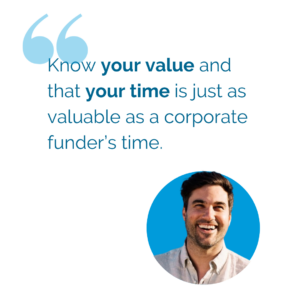 WM: Know your value and that your time is just as valuable as a corporate funder’s time, and it’s not worth trying to change your program to fit the corporate interests, because we do have a corporate interest. We do want to move our business forward, and if that is going to hinder your work as a nonprofit, if that’s going to drain your time as a leader in a nonprofit, then don’t do it. It will be much better to find another partner.
WM: Know your value and that your time is just as valuable as a corporate funder’s time, and it’s not worth trying to change your program to fit the corporate interests, because we do have a corporate interest. We do want to move our business forward, and if that is going to hinder your work as a nonprofit, if that’s going to drain your time as a leader in a nonprofit, then don’t do it. It will be much better to find another partner.
I think as a fundraiser you often look at the field of foundations and you look at their assets, and you think, “ohh this organization has X amount of money, they can definitely spare some money for us.”
But with corporate giving, and many foundations, funding determinations are often driven by answers to questions like, “Where are we contextually relevant? Where do we have expertise and experience?” For instance at Bridgestone, we have scientists and researchers. We have an environment and health department. We’ve got a legal department, and so all these areas where we have valuable experience should be leveraged to further our grantmaking. We’re not just giving money, but we’re also leveraging our talent and skills to go that much further, which means that we can’t give to everyone, but instead we give in a way that is going to leverage our resources. And I think that’s going to make for a better relationship with our nonprofit partners.
Implementing Diversity, Equity, and Inclusion Initiatives
JL: What has centering DEI in your career looked like?
WM: At The Addis Clinic, we worked with state departments and other organizations to deliver telemedicine services in underserved areas in East Africa, refugee camps, and other areas where primary care was not readily available. I was a white male providing direct services to refugee communities. While I recognized that my white privilege conferred certain advantages when it came to fundraising and other aspects of the executive director role, I felt the responsibility to create opportunities for others to lead. As a result, I worked to create a succession plan so that I would be co-director alongside a female healthcare provider.
Prior to the Addis Clinic, I was at Tennessee Justice for Our Neighbors, which provided legal assistance to people seeking asylum and other humanitarian forms of legal relief, and supported victims of violent crimes who needed mental health services and trauma counseling. There, we observed a gross inequity in the number of people of color who were judges and lawyers. In response, we created a six-week summer program to give young BIPOC college students access to judges and lawyers as mentors. We admitted students to the summer program by taking the inverse of what law school currently looks like, which is approximately 3% Latino, 10% African American, and 30% women. It was a refreshing way of looking at entrenched systems of society. I would like to see that in more areas of my work going forward.
Now at Bridgestone Americas, I inherited the current committee that manages the trust fund. Fortunately our leaders were really thoughtful about the composition of the committee, but I think there’s still some work to do in terms of diversity. We want to articulate our commitment to diversity, equity, and inclusion through a simple statement of our values and principles. We want to encourage participation from the next generation of leaders at the company, include more voices from underrepresented groups within the company, and be champions for our employee resource groups. We are democratizing grantmaking within the company through employee matching gifts and empowering employee resource groups to provide unrestricted operating grants to nonprofits.
You can learn more about the Bridgestone Americas Trust Fund here. If you found this conversation thought-provoking, keep your eye on this space for new Elevate Q&As in the coming months.
At Elevate, we’ve been thinking a lot this year about Artificial Intelligence (AI) and how it could influence the way that we perform our work supporting nonprofits in building more sustainable grants programs. AI is increasingly relevant in everyday business operations across numerous industries, and it has been applied for many years in ways that many people don’t realize – mapping apps like Google Maps, voice assistants like Alexa and Siri, even the autocorrect feature in your texting app or word processing software are powered by artificial intelligence.
Some interesting trends have emerged in 2023, which hint at AI’s potential while also raising significant ethical and information security considerations. A recent Forbes Advisor survey reports that:
- ChatGPT, an AI powered large language model, had 1 million users within the first five days of being available.
- 54% of survey respondents believe that AI tools like ChatGPT can improve written content by enhancing text quality, creativity, and efficiency in various content creation contexts.
- AI is expected to see an annual growth rate of 37.3% between now and 2030.
- The majority of consumers are concerned about business use of AI.
Accordingly, Elevate is treading optimistically – yet cautiously – when it comes to AI! While we are exploring how AI can create efficiencies in our work, we are also committed to maintaining the highest quality and privacy standards for our clients.
I recently spoke with a handful of my most forward-thinking and tech-savvy Elevate colleagues, who offered their thoughts on what AI applications are and aren’t helpful in aspects of their work advising nonprofit clients. We share their insights here for your consideration as we all navigate this brave new world.
Because many of the questions Elevate receives about AI are about ChatGPT specifically, we begin with the 411 on this tool.
Even if you haven’t yet used it yourself, you’ve undoubtedly heard the buzz about ChatGPT. ChatGPT is a free, natural language processing tool that can answer questions and support users with tasks such as composing emails, essays, and code. It can spew out responses in a matter of seconds. It does this by analyzing your question or prompt, then – using the dataset it was trained on – predicting the next word or series of words based on what you’ve entered.
But is it savvy enough to write sophisticated, nuanced, and winning grants?
Our colleagues were unequivocal in their response: Not even close.
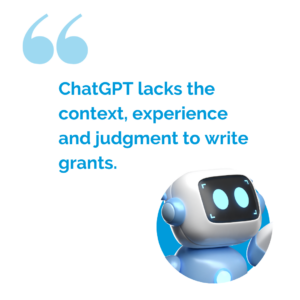 This is because ChatGPT lacks the context, experience and judgment to handle such complex work. Even when I asked ChatGPT “What are the Pros and Cons of Using ChatGPT for grant writing?” it didn’t disagree! While ChatGPT praised its speed and ability to maintain consistency in “tone, language, and messaging” across various sections of a grant proposal and to polish language, it cautioned that it may not fully appreciate the “nuances” of grant guidelines, that it has limitations in understanding the context of an organization’s work and history, and that it could also produce plagiarizing text.
This is because ChatGPT lacks the context, experience and judgment to handle such complex work. Even when I asked ChatGPT “What are the Pros and Cons of Using ChatGPT for grant writing?” it didn’t disagree! While ChatGPT praised its speed and ability to maintain consistency in “tone, language, and messaging” across various sections of a grant proposal and to polish language, it cautioned that it may not fully appreciate the “nuances” of grant guidelines, that it has limitations in understanding the context of an organization’s work and history, and that it could also produce plagiarizing text.
The text that ChatGPT generates in response to a question or prompt might not even be factual – there are absolutely no assurances that the information is accurate or true.
What’s more, because ChatGPT and other AI models draw upon existing content, AI can reflect underlying societal biases, perpetuating stereotypes and white supremacist notions. At Elevate, we know that historically marginalized communities are not “vulnerable” objects of charity, but agents and partners of the social change that they desire to see. This level of social context is far too complex for an AI-powered language model to appropriately reflect.
So, what are the appropriate uses of ChatGPT?
If you do want to experiment with ChatGPT in your writing tasks, we suggest using it for simpler, less analytical tasks, such as condensing word count, identifying alternative phrasing to avoid repetition, or summarizing the main points of your research into more readable language.
ChatGPT also has the potential to provide administrative support for your work, and can be harnessed to:
- Organize a to-do list
- Summarize meeting minutes
- Brainstorm ideas
But whatever you do, do NOT rely on ChatGPT to produce your next grant proposal.
 I know what you are thinking: It’s no surprise that a grant writing firm is telling me not to use an AI tool to write grants! But we are not just saying this because we want to be your grant writers. (Though we DO want to be your grant writers!)
I know what you are thinking: It’s no surprise that a grant writing firm is telling me not to use an AI tool to write grants! But we are not just saying this because we want to be your grant writers. (Though we DO want to be your grant writers!)
At Elevate, we firmly believe that good grant writing is a thoughtful, strategic exercise that requires skill, nuance, and informed decision making. ChatGPT – like other AI tools – is neither thoughtful nor strategic. It lacks discernment of nuance, and is incapable of making reasoned choices about how to present an organization’s work to a funding partner.
Simply producing large volumes of content – that may or may not be factual! – is NOT the point of grant writing. And this is truly all that ChatGPT is doing: generating text.
AI Tools CAN Help You Take Notes, Summarize Content, and Find Information
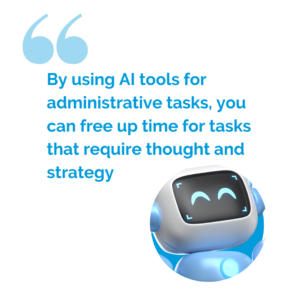 At Elevate, some of our staff are experimenting with the use of AI-powered tools such as Simon Says AI and Fathom Notetaker to capture meeting notes and provide summaries of important conversations that they need to refer back to later or share with colleagues who couldn’t attend meetings. By using AI tools for more administrative tasks, you can free up some of your own time and energy for tasks that require thought and strategy – something AI can’t do!
At Elevate, some of our staff are experimenting with the use of AI-powered tools such as Simon Says AI and Fathom Notetaker to capture meeting notes and provide summaries of important conversations that they need to refer back to later or share with colleagues who couldn’t attend meetings. By using AI tools for more administrative tasks, you can free up some of your own time and energy for tasks that require thought and strategy – something AI can’t do!
As a tool developed by Google, Bard can interface with Google Workspace tools, if you choose to connect these. This means, you can ask Bard to find dates, taks, or other information in gmail, or to summarize a report a colleague shared via Google docs.
Interested in exploring more options for what you can do with AI tools? Check out FutureTools.io, which aggregates AI tools suited for different purposes.
Please Please Please: Inform yourself about privacy!
If you take only one thing away from this article, I hope it is this: get informed about the privacy of the information you share with AI tools, and take precautions to protect your information.
When using any cloud-based technology platform, it is imperative that consideration be given to the way these tools use, store, and share information. Depending on your privacy settings, information you share with tools like Bard and ChatGPT may be used to improve its own language model. This means your data may not only be available to its creators (OpenAI), but also to others who use the platform.
For instance, when first accessing Bard, users are notified that Google will collect conversations and other information like the user’s location, store this data for a period of time, and use it to refine the tool. Furthermore, users are informed that “human reviewers read, annotate, and process your Bard conversations,” and they are warned to not share confidential information.
 For these reasons, think carefully about what information you share with AI tools. Remember that a grant application may include information about your organization, programs, staff, and future plans that might be considered private. A good rule of thumb is, if you wouldn’t want a piece of data or information on your public website for anyone to find, you should not share that information with an AI tool.
For these reasons, think carefully about what information you share with AI tools. Remember that a grant application may include information about your organization, programs, staff, and future plans that might be considered private. A good rule of thumb is, if you wouldn’t want a piece of data or information on your public website for anyone to find, you should not share that information with an AI tool.
How is your organization using AI powered tools, and what have you found useful, scary, hopeful, or exciting about these tools? We invite you to share!
Are you still feeling overwhelmed, or do you want to learn more? Here are a few sources the team at Elevate is using to stay informed:
It is not uncommon for human services organizations to rely heavily on public funds – grants and contracts from local, state, or federal agencies. In fact, many would argue that this is the way it should be, that it is the responsibility of the government to fund housing efforts, health services, maternal healthcare, early childhood programs, arrest diversion, mental and behavioral health initiatives, and other programs that address the needs of vulnerable members of society.
So what does this mean for fundraising from private foundations in the field of human services?
 Diversified revenues are crucial for just about any organization, creating sustainability and resilience when a funding source runs dry. While human services organizations may have a substantial public funding portfolio, and many government grants require a private funding match, this does not mean that other sources of revenue – including earned income and philanthropic funds – should take a back seat in your funding strategy. In fact, I encourage you to think differently about philanthropy and its role in supporting human services providers.
Diversified revenues are crucial for just about any organization, creating sustainability and resilience when a funding source runs dry. While human services organizations may have a substantial public funding portfolio, and many government grants require a private funding match, this does not mean that other sources of revenue – including earned income and philanthropic funds – should take a back seat in your funding strategy. In fact, I encourage you to think differently about philanthropy and its role in supporting human services providers.
Imagine you’re on the leadership team of a service provider that implements a highly effective program for returning citizens; clients successfully maintain housing and jobs, and avoid further justice-system involvement. A contract with the state Department of Justice makes up the majority of the program budget, with the balance coming from a Master Leasing initiative and one wealthy individual donor who gives annually. For the most part, the program is meeting the needs of the population it currently reaches, but there is zero capacity for expansion, innovation, or outreach.
The Board and leadership team is concerned with the long-term sustainability for the program, and next steps involve developing a strategy to diversify revenues for the organization. A discussion ensues around pursuing foundation grants as a key tactic for diversification. The leadership team considers which aspects of the program may be well-suited to private grant opportunities. Should you seek grant opportunities for direct program expenses like rent and food assistance? Or are foundations more likely to support a new outreach component focused on engaging those who are incarcerated before their release? Perhaps you should seek General Operating Support?
If invited to that debate, I would argue that public funds can and should be used for direct programmatic expenses, 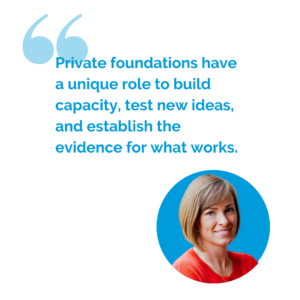 whereas there may be a unique role for private foundations to provide the funding needed to build capacity, test new ideas, and establish the evidence for what works.
whereas there may be a unique role for private foundations to provide the funding needed to build capacity, test new ideas, and establish the evidence for what works.
My advice to the leadership and development teams at human services organizations: Do not primarily think of private foundation grants and other philanthropic contributions as a budget gap-filler. Consider where public funds can and should be used, and where private philanthropy can have a unique impact.
For example, social services organizations might focus philanthropic asks on:
- Well thought-out new initiatives for which you need to establish proof of concept before advocating for public investment;
- Support for concrete diversity, equity, and inclusion initiatives;
- Organizational capacity building (investments in a strategic plan, executive coach, or development strategist, for example);
- Initiatives that are crucial to your clients’ wellbeing where public funders limit their support (such as access to abortion services, gender-affirming care, or harm-reduction initiatives); and
- General Operating Support!
 Above all, the grant request most likely to be funded is the one that is aligned with the foundation’s own priorities, adheres to its proposal guidelines, and for which you have the encouragement of foundation program officers, Board members, or other decision makers to apply.
Above all, the grant request most likely to be funded is the one that is aligned with the foundation’s own priorities, adheres to its proposal guidelines, and for which you have the encouragement of foundation program officers, Board members, or other decision makers to apply.
Is your organization ready to establish (or grow) a private grants program? The team at Elevate can help! Reach out to us at hello@elevatedeffect.com to learn more about our work with nonprofits throughout the U.S. to build smart and strategic grants programs.
A version of this article was originally published in the Summer 2023 edition of The Provider Newspaper, the flagship publication of the Providers’ Council.
A few months ago, we published a Q&A with April Walker of Philanthropy for the People, in which April provided her perspective on centering equity and inclusion in nonprofits, and the limitations of institutional philanthropy in the pursuit of equity. As promised, we are back with more ideas and strategies from April for our readers!
Centering equity and inclusion in any manner of organization is a long-term effort that requires financial resources and buy-in from both staff and leadership. Unfortunately, equity has become a co-opted term, and the work so jargonized, that it is often difficult to tell what efforts are substantive and which are performative.
For this reason, we bring you four practical tips for meaningfully centering equity in your nonprofit. We hope that these tips help you in navigating the complex yet essential process of resetting your organization’s culture with a focus on equity.
 Tip 1: Embrace Discomfort. April says: “You can’t gold star or checklist your way through [equity work]. You’re looking to exist in a very messy, uncomfortable space where you have to get comfortable not having the right answers and saying the wrong thing.”
Tip 1: Embrace Discomfort. April says: “You can’t gold star or checklist your way through [equity work]. You’re looking to exist in a very messy, uncomfortable space where you have to get comfortable not having the right answers and saying the wrong thing.”
Centering equity in your organization is not linear work. You will need to get used to engaging in uncomfortable conversations, grappling with hard truths about where your organization is falling short, and examining your biases, both explicit and implicit.
As Dr. Ella Washington, an organizational psychologist, explains, this work is about “making cultural changes, finding new ways to influence people, and making difficult decisions,” which requires an “intentional, nuanced approach.” It is impossible to change a culture, with all its systems, values, and traditions overnight, so be prepared to roll up your sleeves and embrace the uncertainty and challenge!
 Tip 2: Pay Employees a Living Wage. April says: “I urge people to ask, ‘What does our organizational budget look like with everybody at this organization earning a living wage? What does our budget look like with everybody at this organization having quality healthcare benefits? What does our budget look like with everybody having access to professional development?’”
Tip 2: Pay Employees a Living Wage. April says: “I urge people to ask, ‘What does our organizational budget look like with everybody at this organization earning a living wage? What does our budget look like with everybody at this organization having quality healthcare benefits? What does our budget look like with everybody having access to professional development?’”
A nonprofit’s most valuable resource is its staff—without their day-to-day efforts, it would be impossible to achieve any funded outputs or outcomes. Yet, workers in the nonprofit sector remain vastly undercompensated, and many of them identify as members of the most marginalized communities. Boards and funders have also enabled this disparity by focusing on the bottom-line of financials and failing to treat the people who do the work as part of the work itself. But this need not be the case! What if funders played a bigger role in helping nonprofits to better invest in the talent that drives them?
Some funders are starting to wake up to the implications of supporting nonprofits that undercompensate their staff. Dr. Adriane Johnson-Williams, a program officer at the Pyramid Peak Foundation, noted an inconsistency inherent in this approach to philanthropy:
I took it upon myself to tell agency heads I could not in good conscience support a budget that didn’t pay people appropriately, and I backed that up with funding recommendations to support those budgets . . . We would need far less philanthropy in Memphis if we had higher wages. In deciding which programs to fund, if I had taken their board-approved budgets as presented, I would reinforce an expectation that people working in the nonprofit sector deserve less. I would have co-signed the myth that work in the nonprofit sector feeds the soul, so it doesn’t have to feed or clothe or house the body.”
Likewise, nonprofit governance can play an important role in changing compensation practices. The Center for Progressive Reform is an example of a nonprofit that committed to a multi-step process to reach the goal of paying its staff more than a living wage. To do so certainly took advance planning and didn’t happen overnight. First they worked with their board to establish a contingency fund to augment salaries to mitigate inflation; they also upgraded benefits packages, and partnered with Living Wage for US to conduct an individual assessment and achieve certification.
Beyond pay, it is also imperative to provide equitable opportunities for professional development, as well as more intangible measures such as mentorship and networking for staff.
 Tip 3: Hold Leadership and Governance Accountable. April says: “Equity and inclusion also need to be baked into everyone’s performance evaluation, including the executive director’s and board members.”
Tip 3: Hold Leadership and Governance Accountable. April says: “Equity and inclusion also need to be baked into everyone’s performance evaluation, including the executive director’s and board members.”
We hold organizational leaders accountable for other job performance measures, so why should helping to shift workplace culture to advance equity be treated any differently? While we want to be careful not to equate progress with overly-simplified metrics, there are ways to thoughtfully gauge and measure progress over time. Doing so also reinforces the message that everyone at the organization is tasked with this work (see more on this point below).
Creating a culture of accountability in leadership and governance is key to sustaining momentum for long-range, deep-seated work. In the absence of such a culture, “any effort to prevent racial harm or provide proper redress when it occurs will fall short . . . and deepen distrust and disconnection among staff”; it can also impact employee retention and team performance.
 Tip 4: Avoid Tokenization. April says: “Everyone at the organization should be doing equity work so that they can figure out what being an active ally actually looks like.”
Tip 4: Avoid Tokenization. April says: “Everyone at the organization should be doing equity work so that they can figure out what being an active ally actually looks like.”
There are a number of reasons why an organization should ensure that everyone shares in the work of centering equity. First, this work involves transforming workplace culture—if large segments of your organization aren’t engaged, how can a true shift take place?
Additionally, those who experience the most inequity should not disproportionately bear the brunt of these endeavors, both for practical and fairness reasons. Often, the voices of those who are most marginalized are numerically underrepresented in the organization. It is also necessary for those who enjoy the most advantages to learn to leverage their influence to support their colleagues in effecting change. This allyship can take different forms – it does not always look like being front and center.
Finally, you might want to consider a team-based approach to equity work that convenes communities of practice for staff and board members from different organizations to engage in learning sessions, peer sharing, relationship building and coaching. Check out ProInsipre for more tips on this type of team-based model for building equity, as well as other helpful resources and training opportunities.
If your organization has embarked on an equity journey, we’d love to hear what you have learned through this important and challenging work!
Interested in learning more from organizations who have successfully implemented these tips? Stay tuned to this blog for further discussion in our Elevate Q&A series with nonprofits and funders, or join our email list to be the first to know when new content is published.
August 16, 2022
A 2022 analysis completed by Elevate’s Data Team found that our clients’ win rate for general operating support requests is higher than our win rate for program-specific requests, and that this is true for both new and renewal grants.
Given the continued changes in the sector in 2025 – including serious resource constraints for many nonprofits – we wanted to see if the data is still trending the same way. So, we ran the numbers from a full four years of grant applications – from 2020 through 2024 – which included more than 13,500 proposals! During that time, the win rate for general operating support grants was 73.7% (for every 100 grants submitted, 73 were won), whereas the win rate for program support was 66.1%. This mirrors our findings in 2022. Further, all of the other data points that we examined in 2022 were within a few percentage points and the same in their relationship to each other.
What’s our takeaway? This continuing data shows that funder interest in supporting general operating expenses was not a peak COVID aberration. Now, as nonprofits face extreme uncertainty related to funding from public agencies, it is more important than ever to identify and take advantage of opportunities to request funding that truly meets your organization’s needs.
QUESTIONING ASSUMPTIONS
How many times have you heard fundraising advice along the lines of: “Grant proposals that are focused on a specific project or program are more compelling than those requesting general support.” Or: “Foundations want to support programs, not overhead!”
If you have worked in nonprofit leadership, development, or an adjacent role for any measure of time, I am certain that the answer is likely more than you can count!
But how true is this traditional advice?
In recent years, the team at Elevate has observed key trends in the types of grants our clients are winning. We had a hunch that our nonprofit partners were securing more general operating support dollars each year, and that grantmakers are warming to the idea of providing general operating support. And we saw the think pieces; read any listicle on the “top trends in grantmaking” and you’ll undoubtedly see increased general operating support and trust-based philanthropy on top of the list.
Still, we wondered what our own data would reveal. Are Elevate clients winning more general operating support or programmatic grants? How does the amount of grant revenue they secure compare between the two? And is it possible to secure general operating support from a new funding partner, or should we only ask our existing donors for general operating support? So we rolled up our sleeves, typed in our two-factor authentication codes, and dug into our trusty Salesforce database for the answers.
WHAT WE LEARNED
Elevate and our clients win a higher percentage of the General Operating Support grants we submit compared to Program-Restricted grants.
We looked at the overall win rate – the grants secured compared to the total number of grants submitted – for both general operating support and for program support for the two-and-a-half year period from January 1, 2020 to June 30, 2022. During that period, our clients submitted a total of 6,229 proposals. The win rate for general operating support grants was 72.2% (for every 100 grants submitted, 72 were won), whereas the win rate for program support was 66.8%. While this may seem modest, we actually ran a chi-square test to ensure that these results were statistically significant (p < .0001), and not due to random variation. The findings were clear: there are real differences in win rate by request type.
Even when disaggregated by new and renewal grants, win rates are STILL higher for General Operating Support requests.
After examining the above, we wondered whether the result would be different if we broke the opportunities apart by new versus renewal opportunities. An opportunity would be considered “new” if it is one that the organization has never applied to in the past, and a renewal opportunity is a grant they have secured in previous years. Generally, a grantee has a much higher likelihood of securing a renewal grant than a new one. (You already know this if you read our two-part blog on How to Predict the Future!) But we wondered about the likelihood of securing a new grant for General Operating Support.
Interestingly, our findings held true for both new and renewal opportunities. For renewal grant opportunities, the win rate for General Operating Support requests was 92.2%, slightly higher than the win rate for program requests at 87.8%. For new grant opportunities, the win rate for General Operating Support requests was 54.3%, and the win rate for program requests was 47.1%.

On the flip side, the total dollars secured for Program-Restricted grants is more than twice that of General Operating Support.
While the data around win rates is very compelling, we also wondered about the total grant dollars our nonprofit partners secure that is designated as general operating support versus program-restricted funding. Interestingly, for the same set of opportunities that resulted in the win rates in findings #1 and #2 above, our clients secured roughly $370.3 million in programmatic support, as compared with $169.8 million in general operating support – less than half of the total amount of programmatic funding won!

Naturally, we wondered why this is the case, which lead us to our final finding: overall, there are more opportunities to request Program-Restricted grants than there are opportunities to ask for General Operating Support.
While win rates may be higher for general operating support grants, the opportunity to request this type of flexible support is not the norm. Our data set revealed that Elevate clients had nearly 25% more opportunities to request program support than they had opportunities to ask for general operating support.

OUR THOUGHTS ON THE FINDINGS
Our analysis shows how important general operating support is to a holistic grant strategy. And, it shows how our nonprofit clients are both empowered to ask for what they most need, and able to find true philanthropic partners willing to invest in the sustainability and capacity of their organizations.
Still, across the board, foundations invest more dollars in programs than in the operations of their grantees. We view this as a fundamental problem facing our sector today: many philanthropists are unwilling to invest in the necessary infrastructure of nonprofits. And as any nonprofit leader knows all too well, without unrestricted funding to invest in staff, technology, capacity building, anti-racism work, and unanticipated opportunities, nonprofits are hamstrung, unable to innovate or act swiftly to serve their community or constituents when the need arises.
The bottom line is that general operating support is essential to the success of the nonprofit sector. Organizations need flexible funding that they can leverage as needed to advance their missions. And they need more funding partners who are willing to trust nonprofit leaders and invest in organizations in a way that allows them to do their work.
We are hopeful: the data is pointing in the right direction. And, philanthropy must continue to invest even more unrestricted resources in the nonprofits doing the meaningful work of social change.
ABOUT OUR DATA
Elevate uses Salesforce to log thousands of grant opportunities each year across our nearly 100 nonprofit partners. We track information related to which grants are secured and which are lost, how much funding is requested and awarded, whether each grant is for a specific program area or for operating support, and much much more. The results described here come from thousands of data points across all of Elevate’s nonprofit partners. We love data!
June 14, 2022
 Our friends at GrantStation surveyed more than 1,750 representatives of the nonprofit community about grant seeking at their organizations and published a comprehensive report of the findings. The data covers a wide range of topics relating to how organizations tackle grants, the time and resources they invest in their grants programs, the impact of these efforts in terms of grants won and dollars raised, and some of the challenges organizations face in their pursuit of grant funding.
Our friends at GrantStation surveyed more than 1,750 representatives of the nonprofit community about grant seeking at their organizations and published a comprehensive report of the findings. The data covers a wide range of topics relating to how organizations tackle grants, the time and resources they invest in their grants programs, the impact of these efforts in terms of grants won and dollars raised, and some of the challenges organizations face in their pursuit of grant funding.
At Elevate, we have partnered with hundreds of nonprofits to implement effective grants programs, and much of the findings of the State of Grantseeking Survey resonate with our experience. Here are a few of the key data points that caught our attention in this year’s report.
Most organizations report that the grant cycle for their largest grants was between one and six months from when the proposal was submitted to the day they were notified of their award.
This aligns closely with Elevate clients’ experience. While many foundations make funding decisions at Board meetings held on an annual, semi-annual, or quarterly basis, others have more flexible review processes that allow them to make funding decisions quickly. We find that well-cultivated opportunities with more progressive, less bureaucratic funders tend to have the quickest turn-around times. However, in most cases you can expect a response to your grant request on a slightly longer timeframe – 4 to 6 months after a proposal submission.
It takes a lot of staff capacity to prepare a strong grant! 63% of organizations report that 1-2 staff worked on their largest grant requests, while 25% of organizations have 3-5 staff directly involved in the grantseeking process.
It’s worth noting that having more individuals involved is not necessarily a bad thing – by engaging your finance, programs, executive, and other staff in the preparation of a funding request, you can build an effective culture of philanthropy where everyone sees themselves as playing a role in securing the resources needed to implement your organization’s mission. Further, once the funds are secured, you will already have a team in place that understands the proposed activities and outcomes associated with the grant and that is ready to implement!”
Grant writing takes time! Most organizations report spending between two days and two weeks writing a grant application.
When planning to develop a proposal, you’ll need to allocate time to review the application questions or proposal requirements, collect data, stories, and activities from your team, prepare budgets and other attachments, and write the narrative. And we always recommend allowing time for a thorough review – for strategic alignment, clarity, and basic grammar as well as adherence to proposal requirements. We explore much of this planning process in our FREE How to Write Your First Grant webinar.
Relatedly, one of the biggest hurdles for organizations in the grantseeking process is a lack of time and staff capacity to research, write, and submit grants.
However, making an investment of this time and capacity is crucial for the long-term success and sustainability of your grants program. We find that organizations without dedicated expertise (either having grants experts on staff or the advice of an external consultant) and dedicated time (again – internal or external) are far less likely to secure significant revenue from grants. Aside from the time it takes to prepare grants, other challenges nonprofits face in pursuing grant funding include specific funder requirements, competition among peers, and finding well-aligned opportunities. While many of these barriers can be reduced by committing the appropriate resources to your grants program, the bottom line is that building a winning grants program is tough! It takes capacity, expertise, collaboration, hard work, and time to secure funding from grants. Are you interested in learning more about how the grant writing experts at Elevate can help you develop a sustainable and winning grants program? We’d love to hear from you! Reach out to us today to learn more!
July 6, 2020
Though the effects of COVID-19 are far from behind us, hundreds of foundations are already committing to doing grantmaking differently in the wake of this crisis.
In March of this year, the Ford Foundation spearheaded a pledge in partnership with the Trust-Based Philanthropy Project and the Council on Foundations that encourages fellow grantmakers to commit to acting with urgency and finding new ways to support their grantee partners and the communities they serve in response to the COVID-19 pandemic. Since then, nearly 800 foundations have signed on to a long list of commitments ranging from loosening restrictions on current grants, to collaborating with grantees to find creative responses that help them move quickly to serve communities that have been hit the hardest.
This is just one indicator of how the philanthropic landscape is starting to change in response to the global COVID-19 crisis, to better meet the needs of nonprofits and the people they serve. Last month in the second session of Elevate’s Summer Conversation Series, we took a closer look at what the future of philanthropy could look like if practices like trust-based philanthropy, participatory grantmaking, and less restrictive guidelines for grantees become more common. We also discussed how nonprofits can play a role in affecting these types of changes in giving.
Below are three of the biggest takeaways from that conversation:
1. Advancing equity in giving is a two-way street
Some funders are focusing more on equity now, but not all of them are — which means that whether we like it or not, nonprofits also need to work together to play a role in advancing greater equity in giving.
One simple way nonprofits can help bring equity to the forefront? Claim or update your Guidestar profile and share your organization’s demographic data. Doing so can help us all get a clearer picture of where we are collectively as a sector in terms of equity, plus it gives funders a more complete understanding of your organization — especially for those who are doing their research and actively looking for ways to give more equitably.
2. Find ways to provide feedback to funders
It’s not uncommon for nonprofits to ask your funders for feedback — but in this Conversation Series session, our panelists highlighted just how important it is that we also find ways of providing feedback to funders about how they can adapt their giving practices to be more equitable, and make a greater impact.
Asia Hadley, Director of Partnerships – South at Candid and one of our panelists, gave an example of a funder in Atlanta who gave out a round of grants — none of which went to Black-led organizations. When the community members were rightfully upset, they got together with several Black-led groups and held a discussion where they invited funders in to raise the issue, and discuss how to make sure more of these organizations would be included in the next funding cycle. Examples like this illustrate the power of collective organizing to start some of those larger conversations.
Similarly, developing relationships with your funders can also go a long way. As one of our panelists, Jovana Djordjevic, said: “It’s important to build relationships with funders that aren’t just transactional — we can support them in doing things differently.”
Related: Three Steps for Creating a Grants Program That’s Built to Last
3. Consider the power of collective action in affecting change
If you’re in a particularly challenging situation with a funder, one solution for offering feedback is to consider collaborating with other organizations working together to start those important conversations. There are many benefits to collective action, and reasons why it’s an effective mechanism for affecting change. As our panelist Asia Hadley put it: “Every time we speak up in a collective way, that’s an opportunity to make the whole sector better.”
Initiatives like the Trust-Based Philanthropy Project illustrate how feedback from grantees can push funders to reconsider their practices — and ultimately band together and commit to changing the dynamic of the grantor-grantee dynamic to be more collaborative.
June 18, 2020
With all the uncertainty brought on by COVID-19, there’s one thing we know for sure: nonprofits across the sector have questions and concerns about how to adapt.
In a poll we conducted during the first session of Elevate’s Summer 2020 Conversation Series, nearly two-thirds of nonprofit professionals surveyed said they were actively concerned about how they should be adjusting their budget, strategic plan, and programs — and in what timeframe.
Additionally, nearly half of the nonprofit professionals surveyed reported uncertainty about how fundraising is impacted during times of crisis, how policies and practices are changing among both government agencies and the funding community.
All of this points to a common question about where we go from here, and how to do things differently in an era of COVID-19, racial injustice, and civic activism.
Last week, we kicked off our semiannual Conversation Series with an interactive panel discussion featuring leading thinkers and researchers from Independent Sector, the National Committee for Responsive Philanthropy, and the Nonprofit Risk Management Center. Our conversation addressed many questions about how nonprofits can respond in the short-term, take practical risk, and plan for the future — even when the future feels uncertain.
Below are some of the top few takeaways from last week’s panel discussion on how nonprofits can move forward in spite of the uncertainty we’re all facing.
1. Ask your funders for what you need
As all three of our panelists echoed, this is a great time to talk to your funders, if you haven’t already — particularly if you’ve received restricted funding. Across the board, we’re seeing that funders want to be supportive, and they’ve been willing to unrestrict grants and be flexible in unprecedented ways. Don’t be afraid to be proactive, start a conversation with your program officer, and ask for what you need.
Related: How to Fundraise in Times of Crisis or Uncertainty
2. Be willing to take risks, and lean into innovation
Melanie Lockwood Herman, Executive Director of the Nonprofit Risk Management Center, spoke to the importance of risk and experimentation with a sense of balance. Nonprofits should definitely be willing to take risks, and to ask for funding to do things they haven’t done before. In fact, funders right now have been very open to discussing new ideas and ways of doing things! But if every initiative for which you’re seeking support is very risky, you’ll end up with an unbalanced portfolio.
When it comes to your approach to fundraising and any new programs or initiatives, some ideas should be very experimental with a lower chance of success, but you should also be pursuing funding for programs that have proven success. Aim for a balance.
3. Prioritize Advancing Equity
Related to the previous point about innovation: as your organization thinks about innovating and evolving, advancing equity should be a priority — one that helps shape the ways you think and talk about your work moving forward. As Allison Grayson, Director of Policy Development and Analysis at Independent Sector put it: “We cannot rebuild the system we had before, we have to build it back better and in a more equitable way… as a nonprofit organization, I would think about how my mission ties in with that narrative.”
4. Start Planning now for business continuity
It’s important that your organization has a continuity plan to ensure your ongoing ability to deliver services in spite of interruptions, both on a short- and long-term basis. For example, while we may be seeing increased giving right now, it’s likely that we could see decreases over the next six years. This is more proof that now is the right time to be talking with your funders and making the case that unrestricted general operating support is going to increase your organizational sustainability over the long-term.
Related: Every Organization Needs an Emergency Preparedness Plan. Here’s Ours.






 BR: I will share an example of resuscitating a relationship that lapsed prior to my arrival at the Los Angeles Ronald McDonald House. I told my boss, “Challenge accepted.”
BR: I will share an example of resuscitating a relationship that lapsed prior to my arrival at the Los Angeles Ronald McDonald House. I told my boss, “Challenge accepted.”  BR:
BR:  BR:
BR: When was the last time that you picked up a phone call from “Unknown Caller”?
When was the last time that you picked up a phone call from “Unknown Caller”? Yes, the funder’s website or RFP will outline the official funding priorities, application guidelines, and deadlines. Do you know what it won’t share? You won’t read about the not-yet-official funding priorities that may be incredibly well-aligned with your program and that may even offer a much larger funding amount. The website also won’t recommend that you apply in this current grant cycle because the next one is much more competitive for a smaller pot of money.
Yes, the funder’s website or RFP will outline the official funding priorities, application guidelines, and deadlines. Do you know what it won’t share? You won’t read about the not-yet-official funding priorities that may be incredibly well-aligned with your program and that may even offer a much larger funding amount. The website also won’t recommend that you apply in this current grant cycle because the next one is much more competitive for a smaller pot of money.  At least as far as we are aware, foundations do not feed their grant proposals into an AI system to review and make funding decisions. Review Committees are made up of humans, and these humans decide which applicants will receive their much coveted dollars.
At least as far as we are aware, foundations do not feed their grant proposals into an AI system to review and make funding decisions. Review Committees are made up of humans, and these humans decide which applicants will receive their much coveted dollars. Wade Munday:
Wade Munday: WM:
WM:  This is because ChatGPT lacks the context, experience and judgment to handle such complex work. Even when I asked ChatGPT “What are the Pros and Cons of Using ChatGPT for grant writing?” it didn’t disagree! While ChatGPT praised its speed and ability to maintain consistency in “tone, language, and messaging” across various sections of a grant proposal and to polish language, it cautioned that it may not fully appreciate the “nuances” of grant guidelines, that it has limitations in understanding the context of an organization’s work and history, and that it could also produce plagiarizing text.
This is because ChatGPT lacks the context, experience and judgment to handle such complex work. Even when I asked ChatGPT “What are the Pros and Cons of Using ChatGPT for grant writing?” it didn’t disagree! While ChatGPT praised its speed and ability to maintain consistency in “tone, language, and messaging” across various sections of a grant proposal and to polish language, it cautioned that it may not fully appreciate the “nuances” of grant guidelines, that it has limitations in understanding the context of an organization’s work and history, and that it could also produce plagiarizing text.  I know what you are thinking: It’s no surprise that a grant writing firm is telling me not to use an AI tool to write grants! But we are not just saying this because we want to be your grant writers. (Though we DO want to be your grant writers!)
I know what you are thinking: It’s no surprise that a grant writing firm is telling me not to use an AI tool to write grants! But we are not just saying this because we want to be your grant writers. (Though we DO want to be your grant writers!)  At Elevate, some of our staff are experimenting with the use of AI-powered tools such as
At Elevate, some of our staff are experimenting with the use of AI-powered tools such as  For these reasons, think carefully about what information you share with AI tools. Remember that a grant application may include information about your organization, programs, staff, and future plans that might be considered private.
For these reasons, think carefully about what information you share with AI tools. Remember that a grant application may include information about your organization, programs, staff, and future plans that might be considered private. Diversified revenues are crucial for just about any organization, creating sustainability and resilience when a funding source runs dry.
Diversified revenues are crucial for just about any organization, creating sustainability and resilience when a funding source runs dry. whereas
whereas  Above all, the grant request most likely to be funded is the one that is aligned with the foundation’s own priorities, adheres to its proposal guidelines, and for which you have the encouragement of foundation program officers, Board members, or other decision makers to apply.
Above all, the grant request most likely to be funded is the one that is aligned with the foundation’s own priorities, adheres to its proposal guidelines, and for which you have the encouragement of foundation program officers, Board members, or other decision makers to apply.  Tip 1: Embrace Discomfort. April says: “You can’t gold star or checklist your way through [equity work]. You’re looking to exist in a very messy, uncomfortable space where you have to get comfortable not having the right answers and saying the wrong thing.”
Tip 1: Embrace Discomfort. April says: “You can’t gold star or checklist your way through [equity work]. You’re looking to exist in a very messy, uncomfortable space where you have to get comfortable not having the right answers and saying the wrong thing.” Tip 2: Pay Employees a Living Wage. April says: “I urge people to ask, ‘What does our organizational budget look like with everybody at this organization earning a living wage? What does our budget look like with everybody at this organization having quality healthcare benefits? What does our budget look like with everybody having access to professional development?’”
Tip 2: Pay Employees a Living Wage. April says: “I urge people to ask, ‘What does our organizational budget look like with everybody at this organization earning a living wage? What does our budget look like with everybody at this organization having quality healthcare benefits? What does our budget look like with everybody having access to professional development?’” Tip 3: Hold Leadership and Governance Accountable. April says: “Equity and inclusion also need to be baked into everyone’s performance evaluation, including the executive director’s and board members.”
Tip 3: Hold Leadership and Governance Accountable. April says: “Equity and inclusion also need to be baked into everyone’s performance evaluation, including the executive director’s and board members.” Tip 4: Avoid Tokenization. April says: “Everyone at the organization should be doing equity work so that they can figure out what being an active ally actually looks like.”
Tip 4: Avoid Tokenization. April says: “Everyone at the organization should be doing equity work so that they can figure out what being an active ally actually looks like.”



 Our friends at GrantStation surveyed more than 1,750 representatives of the nonprofit community about grant seeking at their organizations and published a comprehensive report of the findings. The data covers a wide range of topics relating to how organizations tackle grants, the time and resources they invest in their grants programs, the impact of these efforts in terms of grants won and dollars raised, and some of the challenges organizations face in their pursuit of grant funding.
Our friends at GrantStation surveyed more than 1,750 representatives of the nonprofit community about grant seeking at their organizations and published a comprehensive report of the findings. The data covers a wide range of topics relating to how organizations tackle grants, the time and resources they invest in their grants programs, the impact of these efforts in terms of grants won and dollars raised, and some of the challenges organizations face in their pursuit of grant funding.